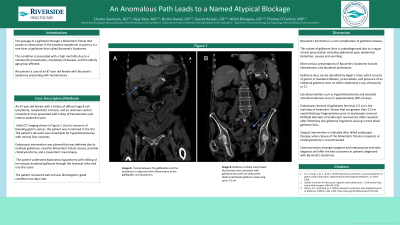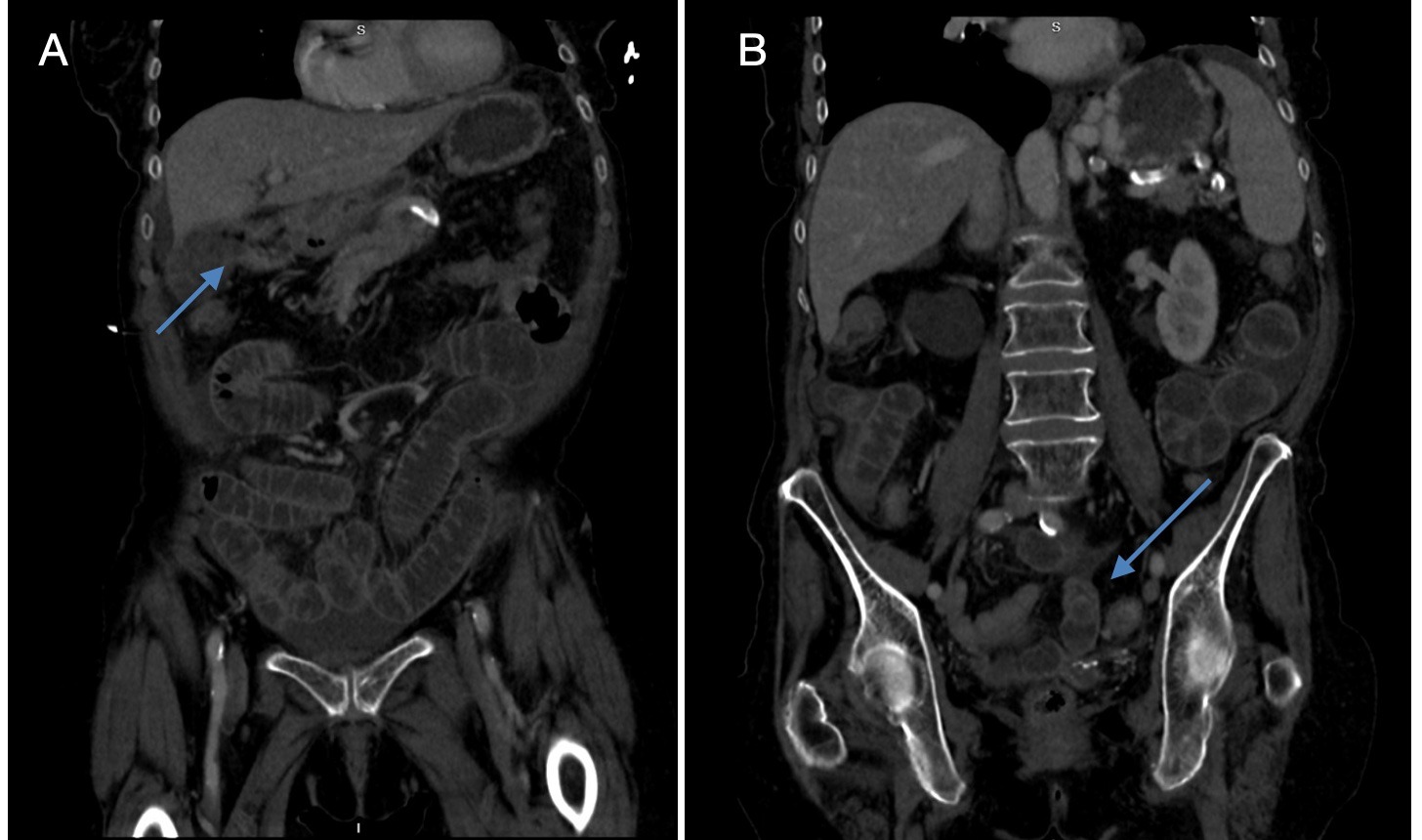Sunday Poster Session
Category: Biliary/Pancreas
P0100 - An Anomalous Path Leads to a Named Atypical Blockage
Sunday, October 22, 2023
3:30 PM - 7:00 PM PT
Location: Exhibit Hall

Has Audio

Charles Swanson, DO
Riverside Medical Center
Kankakee, IL
Presenting Author(s)
Charles Swanson, DO, Vijay Kata, MD, Nistha Rawal, DO, Seerat Hassan, DO, Nikhil Bhargava, DO, Thomas O'Connor, MD
Riverside Medical Center, Kankakee, IL
Introduction: The passage of a gallstone through a bilioenteric fistula that causes an obstruction in the proximal duodenum or pylorus is a rare form of gallstone ileus called Bouveret Syndrome. This condition is associated with a high mortality due to a nonspecific presentation, complexity of disease, and the elderly age group affected. We present a case of an 87 year old female with Bouveret syndrome presenting with hematemesis.
Case Description/Methods: An 87 year old female with a history of diffuse large B-cell lymphoma, nonalcoholic cirrhosis, and an unknown central mesenteric mass presented with 2 days of hematemesis and intense abdominal pain. Initial CT imaging shown in Figure 1. Due to concerns of bleeding gastric varices, the patient was monitored in the ICU. The patient's lab work was remarkable for hyperbilirubinemia with normal liver enzymes. Endoscopic intervention was planned but was deferred due to multiple gallstones, need for bilioenteric fistula closure, possible cholecystectomy, and a mesenteric mass biopsy. The patient underwent exploratory laparotomy with milking of her ectopic duodenal gallstone through the ileocecal valve and into the colon. The patient recovered well and was discharged in good condition two days later.
Discussion: Bouveret syndrome is a rare complication of gallstone disease. This subset of gallstone ileus is underdiagnosed due to a vague clinical presentation including abdominal pain, abdominal distention, nausea and vomiting. More serious presentations of Bouveret syndrome include hematemesis and duodenal perforation. Gallstone ileus can be identified by Rigler’s triad; which consists of gastric or duodenal dilation, pneumobilia, and presence of an intestinal gallstone seen on either abdominal x-ray, ultrasound, or CT. Lab abnormalities such as hyperbilirubinemia and elevated aminotransferases occur in approximately 30% of cases. Endoscopic retrieval of gallstones less than 2.5 cm is the mainstay of treatment. Stones that are greater than 2.5 cm need lithotripsy fragmentation prior to endoscopic removal. Multiple attempts of endoscopic removal are often required after lithotripsy due gallstone fragments causing a more distal gallstone ileus. Surgical intervention is indicated after failed endoscopic therapy, when closure of the bilioenteric fistula is required, or cholecystectomy is recommended. Communication amongst surgeons and endoscopists and early diagnosis will offer the best outcomes in patients diagnosed with Bouveret syndrome.

Disclosures:
Charles Swanson, DO, Vijay Kata, MD, Nistha Rawal, DO, Seerat Hassan, DO, Nikhil Bhargava, DO, Thomas O'Connor, MD. P0100 - An Anomalous Path Leads to a Named Atypical Blockage, ACG 2023 Annual Scientific Meeting Abstracts. Vancouver, BC, Canada: American College of Gastroenterology.
Riverside Medical Center, Kankakee, IL
Introduction: The passage of a gallstone through a bilioenteric fistula that causes an obstruction in the proximal duodenum or pylorus is a rare form of gallstone ileus called Bouveret Syndrome. This condition is associated with a high mortality due to a nonspecific presentation, complexity of disease, and the elderly age group affected. We present a case of an 87 year old female with Bouveret syndrome presenting with hematemesis.
Case Description/Methods: An 87 year old female with a history of diffuse large B-cell lymphoma, nonalcoholic cirrhosis, and an unknown central mesenteric mass presented with 2 days of hematemesis and intense abdominal pain. Initial CT imaging shown in Figure 1. Due to concerns of bleeding gastric varices, the patient was monitored in the ICU. The patient's lab work was remarkable for hyperbilirubinemia with normal liver enzymes. Endoscopic intervention was planned but was deferred due to multiple gallstones, need for bilioenteric fistula closure, possible cholecystectomy, and a mesenteric mass biopsy. The patient underwent exploratory laparotomy with milking of her ectopic duodenal gallstone through the ileocecal valve and into the colon. The patient recovered well and was discharged in good condition two days later.
Discussion: Bouveret syndrome is a rare complication of gallstone disease. This subset of gallstone ileus is underdiagnosed due to a vague clinical presentation including abdominal pain, abdominal distention, nausea and vomiting. More serious presentations of Bouveret syndrome include hematemesis and duodenal perforation. Gallstone ileus can be identified by Rigler’s triad; which consists of gastric or duodenal dilation, pneumobilia, and presence of an intestinal gallstone seen on either abdominal x-ray, ultrasound, or CT. Lab abnormalities such as hyperbilirubinemia and elevated aminotransferases occur in approximately 30% of cases. Endoscopic retrieval of gallstones less than 2.5 cm is the mainstay of treatment. Stones that are greater than 2.5 cm need lithotripsy fragmentation prior to endoscopic removal. Multiple attempts of endoscopic removal are often required after lithotripsy due gallstone fragments causing a more distal gallstone ileus. Surgical intervention is indicated after failed endoscopic therapy, when closure of the bilioenteric fistula is required, or cholecystectomy is recommended. Communication amongst surgeons and endoscopists and early diagnosis will offer the best outcomes in patients diagnosed with Bouveret syndrome.

Figure: Fistula between the gallbladder and the duodenum, indicated by a blue arrow, is observed with inflammation of the gallbladder and duodenum (A). There is evidence of distal small bowel obstruction most consistent with gallstone ileus with an obstructive distal small bowel gallstone measuring up to 1.9 cm, indicated by a blue arrow (B).
Disclosures:
Charles Swanson indicated no relevant financial relationships.
Vijay Kata indicated no relevant financial relationships.
Nistha Rawal indicated no relevant financial relationships.
Seerat Hassan indicated no relevant financial relationships.
Nikhil Bhargava indicated no relevant financial relationships.
Thomas O'Connor indicated no relevant financial relationships.
Charles Swanson, DO, Vijay Kata, MD, Nistha Rawal, DO, Seerat Hassan, DO, Nikhil Bhargava, DO, Thomas O'Connor, MD. P0100 - An Anomalous Path Leads to a Named Atypical Blockage, ACG 2023 Annual Scientific Meeting Abstracts. Vancouver, BC, Canada: American College of Gastroenterology.
